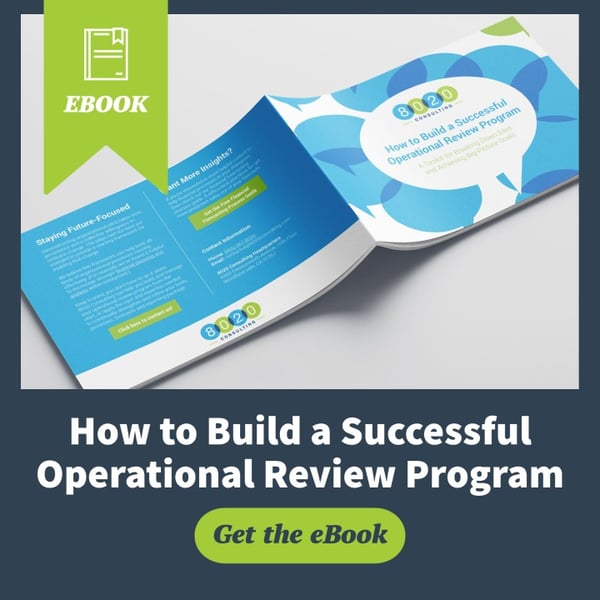
A well-structured Financial Planning & Analysis (FP&A) team can facilitate the direction of a company, leveraging organizational strategy to guide departmental objectives. Think of FP&A as the financial nucleus of an organization: it keeps the movement and momentum of the organization synchronized—both financially and operationally.

Because FP&A plays a critical role in an organization’s long-term effectiveness, it makes sense for companies to focus on building FP&A infrastructure as early as possible. However, it’s common for companies to ignore this foundational work to focus on operational firefighting and ad hoc reporting.
In this blog, we’ll examine why focusing on building FP&A infrastructure should be a higher priority for growth-focused companies—and why bringing it to the forefront now can save a lot of headaches later.
FP&A aligns departmental objectives with an organization’s goals.
Departmental objectives may seem straightforward, and maybe even simple and easily manageable. But what happens when these objectives are stacked alongside those of other departments? Do they align? Are they competing priorities? And how do they all connect with the organization’s overarching goals?
These are questions FP&A can help answer.
Let’s create a simplified example to illustrate that more clearly: An organization has set out to be a top-selling outerwear company in its region. Sales, Marketing, and IT have the following priorities:
- The Sales team plans to sell $50 million worth of product by the end of the year.
- The Marketing team plans to launch marketing campaigns to support Sales. Marketing is also working on the company’s re-branding that will debut this year.
- IT plans to ensure its eCommerce technology is robust enough for the anticipated sales. IT is also working on implementing a more advanced reporting system this year and has been struggling with unforeseen turnover.
When we look at the goals together, rather than fixating on them by department, they’re not so straightforward.
Suppose Sales plans to achieve 30% of their $50 million goal during the winter holiday season. This is similar to prior-year benchmarks, so the Head of Sales makes this sales commitment without hesitation. He envisions that planning and budgeting will be similar to those years: robust budget, parallel timelines, and comparable resources.
What the Head of Sales doesn’t consider is that this year will be quite different from prior years. The company will be launching its much-anticipated re-branding, so Marketing’s resources will be stretched thinner this year, including its employees and dollars. The company will also implement a new reporting system. Though IT has committed to a year-end implementation date, recent unforeseen turnover within the group will likely delay the initial project timeline. Unless additional resources can be attained and attained quickly, IT may need to postpone the implementation to next year.
A strong FP&A team can help plan and forecast resources, incorporate capital considerations, streamline timelines, and align goals. In this example, FP&A can help the organization with the following:
- Develop KPIs and a scorecard for each department to ensure they are on track throughout the year. KPIs may include: ROIs for each product to identify most profitable products sold, budgeted vs. actual dollars spent for various Marketing campaigns, milestone dates for system implementation.
- Identify available capital and resources to help alleviate and mitigate areas of risk. For example, if Marketing and IT resources are being stretched too thinly, FP&A could re-allocate available dollars, perhaps to hire a temporary third-party to support Marketing’s re-branding and/or help expedite the hiring of IT’s open positions. A strong FP&A team will ensure an organization’s capital is being utilized in its best interest and priorities.
- Assess and communicate current state, highlights, risks, and opportunities to senior and executive management. FP&A can help look out for financial and operational blind spots for Management. In this example, FP&A would ensure Management is privy to any competing priorities, the implications of each, and how resources and timelines can be aligned, adjusted if necessary, to ensure the success of individual departments and the overall organization.

In essence, a strong FP&A team can help their organization manage alignment by:
- Planning, budgeting, and forecasting for the next several months and years for departments and the overall organization.
- Interpreting and incorporating quantitative and qualitative information, as well as ascertaining implications. These can come in the form of trend reporting, key performance indicators (KPIs) and OKRs (Objectives and Key Results), for example.
- Identifying and incorporating trends, highlights, risks, opportunities, and headwinds for the organization and industry.
- Facilitating calibration and prioritization of agendas and goals of the organization and departments.
- Developing and providing continual and ad hoc reporting and analysis to support key business decisions.
FP&A provides structure to financial ops and executive decision making.
Feats of FP&A are essential for any organization, but they can be especially challenging for those that are growing. In my experience, there are three common symptoms that indicate an organization could benefit from a better-structured FP&A team:
- No one is explicitly responsible for FP&A. If your organization does not have an FP&A team carved out, consider establishing one. Also consider the possibility that your organization may already have the functioning resources, but just hasn’t formally developed the team’s infrastructure. Consider establishing the team.
- Reporting and analytical request fire drills are common. If there are financial reporting and analytical requests in the form of continuous rapid-fire requests, consider the cadence an FP&A team could help develop and deliver. These fire drills can come in all shapes and forms. One common form is the request for reporting or status updates for more or less the same information. Continuous ad hoc sales production reporting could evolve more effectively into a weekly production report with established KPIs (e.g., total sales per week, sales month-over-month, units of sales, sales per product, or ROI). The foresight to establish set KPIs will not only mitigate fire drills and unnecessary ad hoc requests but, moreover, will provide a cadence and flow of information FP&A and management can expect and adhere to—a win-win for all.
- There’s a lack of foresight beyond several months. Financially and operationally, an organization should have a driving vision on where it is heading for the next several months, beyond a year. A strong FP&A team will plan beyond 18 months, and even several years out. Lack of preparation will trap an organization in a vortex of chaos and managerial confusion. With proper planning, budgeting, and forecasting, an organization can plan and prepare for hurdles and leap to their milestones, whether it be reaching a revenue goal, re-evaluating product line profitability and growth, expanding footprint across regions.
Building an FP&A team isn’t as difficult as you think.
Successful FP&A infrastructures come in various shapes and sizes across organizations. Because FP&A infrastructure must consider an organization’s business needs, complexity, industry, and size, there’s no one-size-fits-all approach.
Still, at the core of a successful FP&A team are the following principles:
Strong Understanding of FP&A in the Leadership Function
Executives, senior management, and key business partners must understand the role of FP&A. Their grasp of FP&A impacts how much FP&A can contribute to the organization’s success. The better the understanding, the better FP&A can be leveraged and expectations aligned.
Established Processes and Procedures
Reporting and analyses are key components of FP&A’s responsibilities. Many of these components are continuous, whether weekly, monthly, quarterly, annually. Thus, an established cadence is beneficial not only for FP&A, but its stakeholders as well. Processes and procedures can be established informally or formally – from a cross-functional team decision to a formal service-level agreement (SLA). Remember, these agreements are meant to streamline communication and deliverables, not create hindrances.
Also keep in mind the notion of establishing processes and procedures does not mean FP&A cannot be nimble with requests and deliverables. A well-oiled FP&A team can cater to ad hoc requests without issue. Established processes and procedures augment the efficiency and effectiveness of the FP&A team and organization overall.

A Well-Equipped Team
The individuals responsible for FP&A should be equipped with the obvious assets: financial acumen, analytical skills, and the propensity to ask the right questions. Additionally, an organization can use other means to better equip the FP&A role:
1. Organizational Structure
Every organization is set up differently. Some are set up more horizontally, some more vertically, some smaller, some larger. No matter the case, care and thought should be invested when building out FP&A infrastructure. Given the depth of FP&A’s scope of work across the whole organization, it is imperative that FP&A be organizationally positioned and empowered to collaborate directly with senior and executive management and key stakeholders, like department heads. This means Management and stakeholders alike should include FP&A in key business discussions and decisions.
If you’re relying on FP&A to paint a full picture, how can you expect them to deliver without providing all the colors?
In our example, this means that Sales should explain their envisioned timeline of revenue, so FP&A can incorporate financial impacts and point out any internal or external implications Sales may be overlooking. Marketing and IT should share project updates and potential budget constraints. A trusted and empowered FP&A team would assess and analyze all input and align, re-align where necessary, to ensure all parties—departments and Management—are on track with company goals.
Bottom line: No matter how your organization is set up, ensure your FP&A team is incorporated into your organization in a way that sets them (and your organization) up for success. Especially in growing companies, business decisions need to be made soundly and often quickly. Set up your FP&A team so they can help do that.
2. Compatible and Reliable Systems and Tools
Equipping your FP&A team with the right systems and tools is vital. The team is bound to utilize them every day for the well-being of the organization, so financial systems can be a crucial and wise investment. Today, options are almost endless and can be extremely expensive. Cost should never exceed the benefit, so careful financial systems selection is vital. Also consider business model implications, industry best practices, customization preferences, compatibility with systems and tools already in place. Select systems and tools that work for FP&A and the overall organization.
External specialists can make FP&A buildout a lot less stressful.
Building an FP&A team, whether from the ground up or by restructuring your current team, can be a convoluted endeavor. But, with a clear vision and Management support, it is possible to establish one that fits seamlessly into your organization.
8020 has worked with a plethora of organizations to spearhead the development of their FP&A teams and processes. We offer outside expertise with industry best practices. We understand and encourage the importance of organizational alignment and the success that comes with it. You can contact us for assistance, and we'd be happy to help.
If you're interested in learning more about how financial best practices can drive traction on strategic goals, you can also download our free ebook below.
-
Photo by Hal Gatewood on Unsplash
- Photo by Mihai Surdu on Unsplash




